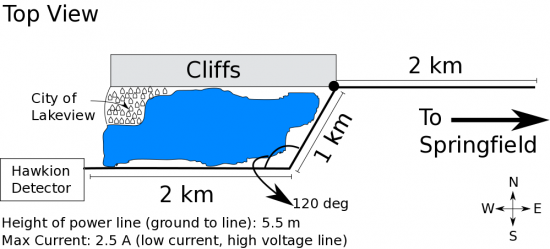Project 9
Project 9A: Sorting Hawkions
Since your team was so successful at creating the magnetic field detector for the hawkions, the Lakeviewians have now hired you to analyze other characteristics of the hawkions. The Hawkions appear to have a variety of masses, so you start by trying to sort out the hawkions by mass (using a mass spectrometer). Before building the spectrometer, your team is asked to develop a model of the spectrometer to determine where the magnetic field should be relative to the catching plate, which stops the hawkions. Below is the beginning of a model that was developed by another team that mysteriously disappeared…
## Model parameters B = vec(0,0,-2) magconstant = 1e-7 ## Objects magplateN = box(pos=vec(1,0,1), length=2, height=2, width=0.1, opacity=0.2) magplateS = box(pos=vec(1,0,-1), length=2, height=2, width=0.1, opacity=0.2) catchingplate = box(pos=vec(4,0,0), length=0.1, height=10, width=10, opacity=1) xaxis = cylinder(pos=vector(-3,0,0), axis=vector(6,0,0), radius = 0.05, color=color.white) yaxis = cylinder(pos=vector(0,-3,0), axis=vector(0,6,0), radius = 0.05, color=color.white) zaxis = cylinder(pos=vector(0,0,-3), axis=vector(0,0,6), radius = 0.05, color=color.white) ## Set up particles i = 0 N = 20 particleList = [] while i < N: particleList.append(sphere(pos=vec(-2-4*random(),0,0), radius = 0.1, m = 20*(random()+1), v = vec(2,0,0), q = 10, color=color.red)) i = i + 1 ## Calculation Loop t = 0 dt = 0.01 while t < 30: rate(300) for thisParticle in particleList: thisParticle.pos = thisParticle.pos + thisParticle.v*dt if thisParticle.pos.x > catchingplate.pos.x: thisParticle.v = vector(0,0,0) t = t + dt
Learning Goals
- Use the right hand rule to relate the charge's speed and external magnetic field to the force on that charge.
- Use circular motion to relate the radius of the particle's trajectory to it's force
- Understand what an “if statement” does in the code
Project 9B: Lakeview's Mystery
You've just received a phone call from the head of the Wildlife Tracking Foundation of Lakeview. Dr. O'Taulest reports that they have recently had an unprecedented disappearance of their green-bellied canaries that like to roost in the cliffs overlooking the lake. Their most popular nesting area on the eastern edge of the cliffs is completely empty. It's almost like they decided to migrate 4 months ahead of schedule! The Wildlife Tracking Foundation is also reporting that the fish, especially those near the north-eastern bank of the lake, have suffered a sudden decrease in their population. Dr. O'Taulest claims that it is all your fault since you had to build a large power line to run the Hawkion detector. Clearly, the magnetic field from the power line interfered with the green-bellied canaries (who rely on Earth's magnetic field for migration purposes), causing their vacation from the vicinity.
As the lead engineers on the Hawkion project, your boss has kindly asked that you disprove Dr. O'Taulest's claims. The company could be facing ridiculous litigation fees if the Wildlife Tracking Foundation has a case against you. To start, you go back and consult the handy-dandy blueprints you drew up when designing the transmission line.

Learning Goals
- Use the right hand rule to determine the direction of the magnetic field near a wire.
- Calculate the magnetic field from a wire segment with a current and explain the role of superposition in your solution.
- Explain what the pieces of the integral are ($d\vec{l}$, $\vec{r}$, and limits) and how you determined them for your solution.
- Relate the magnetic field from a current to the magnetic field from a single moving charge - explain how these are similar and/or different.